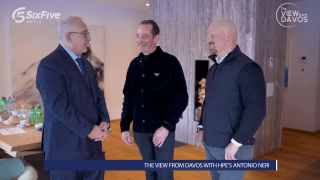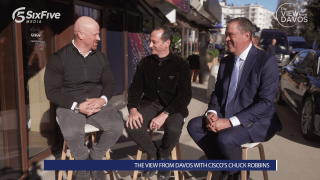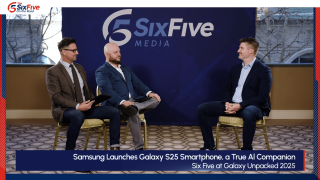The Six Five In the Booth at AWS re:Invent 2022. Patrick Moorhead and Daniel Newman sit down with Nick Brackney, Sr. Consultant, X-ISG, Dell Technologies. Their discussion covers:
- The announcement of Dell PowerFlex on AWS
- Capabilities and benefits of running PowerFlex on AWS
- Why Powerflex on AWS is crucial for enterprise customers
Be sure to subscribe to The Six Five Webcast so you never miss an episode.
You can watch the full video here:
You can listen to the conversation here:
Disclaimer: The Six Five On the Road is for information and entertainment purposes only. Over the course of this webcast, we may talk about companies that are publicly traded, and we may even reference that fact and their equity share price, but please do not take anything that we say as a recommendation about what you should do with your investment dollars. We are not investment advisors, and we do not ask that you treat us as such.
Transcript:
Patrick Moorhead: Hi, this is Pat Moorhead. We are live in Las Vegas at AWS re:Invent 2022, and we are in the Dell Technologies booth. Dan, the excitement, everybody has drinks in hand. What are we doing?
Daniel Newman: We’re working man.
Patrick Moorhead: Yes.
Daniel Newman: But if you look around, this place is buzzing and it’s the afternoon. And people, there’s a few people enjoying a cocktail, a beer, a cocktail, a Red Bull, sugar-free. I’ve asked for one of those. It hasn’t shown up yet, but…
Patrick Moorhead: It’s at the hotel I heard. But anyways, we’ll get there. But the great part about the cloud is we’ve been tracking it since it was the cloud. It’s 15 years old. And now we have the enterprise going to the cloud. The cloud going to the enterprise. I mean just like we said it would a decade ago.
Daniel Newman: Yeah, it’s really moving along and we’re seeing that convergence. Everything that was it’s going to all be Cloud is now like, nope, it’s going to be hybrid. And everything that was like it’s going to be all on Prime is like, nope, it’s going to be hybrid. And so, I think we’ve landed there and now we’re really seeing the growth start to take shape. And we’ve got a great guest here today, Nick Brackney, a friend of ours from Twitter.
Nick Brackney: Hey. Oh, oh.
Daniel Newman: Someone who-
Patrick Moorhead: Don’t you love it when you have been interacting with somebody on Twitter for years and you finally meet them? You’re wondering what their reaction’s going to be. Does their picture now, you have like an NFT or a cartoony type thing?
Nick Brackney: I do. Yeah.
Patrick Moorhead: And you’re, so I actually didn’t know what you looked like for real.
Nick Brackney: Yeah, I spend the time on LinkedIn. There’s the real photo.
Patrick Moorhead: I got you. I mean LinkedIn is moving up, I mean no longer for just job seekers.
Daniel Newman: That’s true.
Patrick Moorhead: Well, I probably spend half my time on LinkedIn now.
Daniel Newman: Now, we could use this episode to talk about whether the NFT will ever make a comeback, but we’re not. We’re not going to do that, Nick. And Nick from Dell that we happen to hang out with on Twitter. But Nick, how about a first and foremost, since I gave you the Twitter intro, give us the real intro? Tell us a little bit about yourself, your role at Dell.
Nick Brackney: Yeah, I’ve been at Dell for about five years now and bounced around, did some storage, did some cloud. Now I’m doing some cloud storage. Funny how that works out.
Patrick Moorhead: Makes sense. Makes sense.
Nick Brackney: With Project Alpine, where we’re taking all of our storage and we’re making it software defined and we’re putting it up into the various public clouds. It’s been a great time. And before that, obviously I spend a lot of time working in cloud and other industries.
Patrick Moorhead: I like that, other industries. Let’s not talk about who we used to work for, but that’s okay. It’s all good. No, I mean listen, the cloud needs some help. And if you think about it, the cloud has technically been around for 15 years. Yet, what, I mean 10, 20, 20 5% of the data in the applications aren’t in the public cloud. A lot of it’s still on-prem in Colo, and in a very large and growing edge. First question is big announcements this week. Let’s talk to the audience about them. I know you love all your babies, but you can only pick a few. What were your top storage announcements?
Nick Brackney: PowerFlex on AWS. PowerFlex was already a software defined piece of storage. What’s really exciting about this is we’re putting it up in AWS that allows customers to take advantage of all that storage IP, the software that we’ve built over the years in a new environment. That’s very exciting.
Daniel Newman: That’s the big one. Talk a little bit about the advance, the capabilities that customers are going to be experiencing, why this is something that Dell is plowing ahead with.
Nick Brackney: I think one of the more interesting ones is the multi-availability zone architecture. That is an option. And what’s really interesting about that is that it’s an Amazon best practice, as you know, to put your application in multiple availability zones and have more resiliency for your applications. We’re doing that for the storage. You can actually stripe it across versus doing two different clusters and doing asynchronous replication. You can do that as well. But this allows you the opportunity to do either or.
Patrick Moorhead: Yeah. Is that better performance? Is it better reliability? What benefit does that provide?
Nick Brackney: I think it’s both. And it could also help drive cost down. I mean obviously, there’s still some challenges with egress that you run into, but…
Patrick Moorhead: Kind of. Egress, sometimes I hear from enterprises it could be 50% of their compute cost.
Nick Brackney: Yeah. But then you look at storage and storage can also be quite expensive as well. Storing in two different clouds at the same time and having the synchronous replication across is also a challenge.
Patrick Moorhead: What’s the experience like? A lot of your customers, I mean super experience, PowerFlex on Dell infrastructure. How does that compare to the experience of PowerFlex on AWS? Does it look the same, smell the same, taste the same?
Nick Brackney: It’s a really good question. We actually, for this version, we didn’t have to change a single line of code. All we had to do was we had to figure out what the underlying infrastructure was and provision on top of it because it’s software defined. That allowed them to have the access to something that they’re already running in production in data centers today. Very exciting stuff.
Patrick Moorhead: Now there’s a lot of different types of storage options in AWS, the same as there’s a lot of storage options with Dell infrastructure. Is there a particular kind of storage in AWS that you sit on top of?
Nick Brackney: Yeah, it’s interesting. There are two options. There’s EC2 based and then there’s EBS based. And so, the difference there is persistent versus non-persistent storage. Maybe I want to save some money and I want to throw something up into the cloud, a workload, maybe it’s a dev test workload. I want to throw 5,000 cores against it, see if I can break it.
And then I want to bring it back down into my data center where I may be running it in production. That might be something that’s great for an EC2 based instance. Because therefore, you’re not having to pay more for the EBS storage layer. Now if I’m going to be using a database or an application and I’m going to be using that for a long period of time in Amazon, I probably want to choose the EBS option.
Daniel Newman: We had a conversation with one of your colleagues, Varun Shargra. And we talked a lot about these forces that are bringing public to prime and prime to public. But one of them is that Dell always has been a company that’s led with meeting its customer where the customer is. For Dell to make a decision to invest in working more closely with AWS and making an important part of its portfolio available, that must have been driven by that customer demand. Talk a little bit about why and how you see this really driving growth for your portfolio.
Nick Brackney: Sure. Absolutely. And when we hear this a lot. There’s a lot of rich enterprise data services that customers rely on in their data centers today. They really needed to be able to access some of those capabilities that are more advanced in the cloud. That’s part of the reason why you might look to a third party versus a native solution.
And so, PowerFlex was our first one out of the gate and people like a lot of the capabilities PowerFlex has. We’re also taking a file to the cloud as well with PowerScale eventually. And we see a lot of demand there as well. There’s a lot of interest in our portfolio and all the storage IP. Most people don’t realize something like 80% of our developers are actually software developers.
Patrick Moorhead: No, Jeff Clark makes that very clear now every time he gets on stage, which I think was very important. And I have to tell you, I know a lot of people look at Dell as an infrastructure only company, but with the amount of engineers and the amount of investments, it is changing. And just the fact that you’re putting your secret sauce software up on AWS I think makes a big statement.
Nick Brackney: Yeah. And I think it’s great for customers because there’s a lot of challenges with moving and switching models. And yes, we’re 15 years in the cloud, but I still think it’s relatively early in cloud. It’s just crazy to say.
Patrick Moorhead: Well, it is, Nick. And there’s a reason why we’re here 15 years later. And whether that was controlled, whether that was latency, whether that was, I don’t really, I don’t have a need to move it. We’re in a much more, I’ll call it the mature stage, where maybe we’re out of the adolescence years and we’re into being teenagers, which means we haven’t figured everything out. We’ve learned a lot of lessons, sometimes the hard way, a lot of hard lessons.
But I think that’s good in the end for customers because no longer is there this board mantra that says, “Thou shalt not invest anything unless it’s the public cloud.” And it’s like, “Oh, interesting.” If even going by the definition of cloud, where it’s scalable, typically can function in a DevOps environment.
You could probably swipe a credit card if you’re a developer and it’s using Linux open source tools. Hey, all those checks the box. That gets me, it’s a long way to this question by the way, which is how does this all play with Apex? How is what you’re talking about here involved in this?
Nick Brackney: There’s a lot of great things that people loved about cloud. And when we looked at Apex, we said, “We have to bring those to the data center.” Where this aspect of Apex is going is that we also need to make sure we do the opposite. Bringing the cloud to the data center, but then also bringing the data center experience to the cloud.
And so, my focus in my work has been really on bringing the data center to the cloud. But you’re absolutely right, the vision for Apex is let people run it where it makes the most sense. And the only way you can do that is if things are consistent. And if you’re giving people that same great experience everywhere because otherwise they have to make trade-offs. And that’s where we start getting into trouble.
And like to your point, you said we used to hear a lot of different conversations getting out of the data center game and stuff like that. And I hear that a lot less now. I hear a lot more of a balanced, really rational approach to how they’re going to use cloud within their IT tool chest.
Daniel Newman: To me it’s really interesting because it’s like we always use the baseball analogies and sometimes it’s in the early innings. And sometimes it’s, we’re in the late innings. And I think every company’s on their own continuum right now. I think some companies got on board early. You’re seeing some companies that got on board, now they’re from on public cloud and they’re pulling back. You see some that really never went and they’re just starting to tiptoe.
And for you and for the Dell portfolio though, I smell so much opportunity to handle this extensibility. Because in the end, like I said, we said really early in the show, Nick, everyone agreed to hybrid. But the migration paths are going to be long. Because the thing is, it’s not like we’re in a stop setting. This is your infrastructure and architecture, now you’re going to…
It’s like every day it changes, the edge gets bigger, the telco cloud grows. Your workloads in the cloud grow, your observability workloads change, security needs are evolving. You’re continuously putting the company in a good position to take advantage of that. Every day the IT people are trying to solve these problems.
Nick Brackney: Sure. And when you think about it, cloud is just a feature. It’s a different way of implementing or delivering that capability at the end of the day. And we’ve done a great job in the data center and the enterprise of getting ourselves in a great position and having the right software that these organizations rely on. And now we’re going to be able to take it to the public cloud here and really make it work anywhere.
Patrick Moorhead: Nick, congratulations on Powerflex and AWS launch.
Nick Brackney: Thank you.
Patrick Moorhead: And I really appreciate you coming on the show. And I have to tell you, it’s great to see you in person. And now, let’s just mix it up a little more on social media. I don’t know, can we? Is that healthy? I don’t know, but I have a lot of fun with it. My brain operates in 280 character loads or whatever we want to call it.
Nick Brackney: I’m so glad they moved off of 140. That was way too short.
Patrick Moorhead: It is.
Daniel Newman: You know what’s funny though? I still struggle with 280. I just want to point that out. I struggled with 140. I struggle with 280. But you’re very good on socials. Good representative of Dell. Congratulations on all the launch.
Nick Brackney: Thank you.
Daniel Newman: And thanks for joining us on the Six Five on the road at Dell at AWS re:Invent. Take a breath, hit that subscribe button. We appreciate everybody tuning in to this episode. We had more from the event with Dell, so make sure you check out those other episodes. For this episode though, it’s time for Patrick, myself and our guest, Nick, to say goodbye. We’ll see you later.






















































































